Basic pasta recipe
Ingredients:
Flour - 400 g
Eggs - 3 pcs.
Water - 2 tbsp.
A pinch of salt
Preparation: Lightly beat the eggs with a fork. Sift the flour into a bowl, make a well in the center and pour the eggs into it. Add water and salt. Knead into a smooth elastic dough. Cover with film and let stand for 30 minutes. Divide the dough into 3 parts, wrap 2 parts in film and set aside. On a floured surface, roll out the remaining dough into a very thin layer and sprinkle with flour.
Fold the dough several times. Cut the folded dough into strips 0.6-0.8 cm wide. Unfold the strips along the entire length and let them dry a little. Make a paste using the rest of the dough as well.
For lasagna, thin layers of dough must be cut into rectangles, the size of which corresponds to the size of your baking dish.
For farfalle, the rolled out dough is cut into squares with a side of 3-4 cm, and then each square is collected in the center into a bow.
Pasta homemade Can be wrapped in cling film and stored in the refrigerator for up to 1 week, and the pasta can be stored in the freezer for 1-2 months.
Colored paste
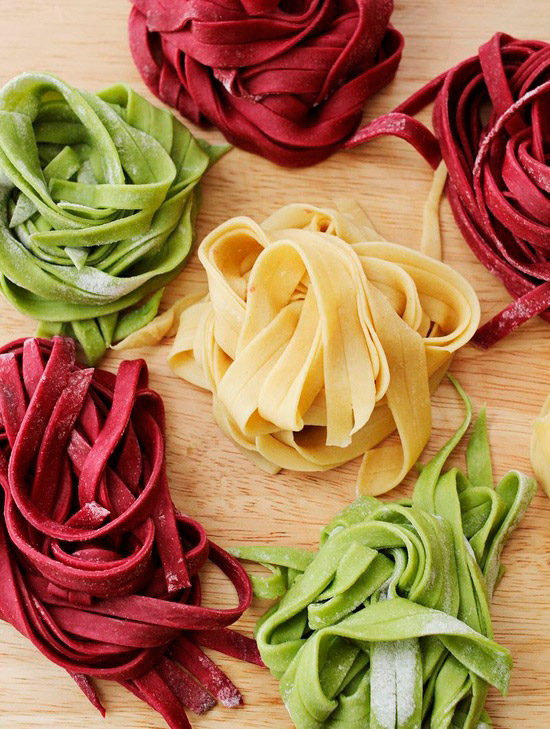
Ingredients:
For the test:
Flour - 400 g
Eggs - 2 pcs.
Beets - half a root vegetable
Carrots - 2 pcs.
Spinach - 75 g
Preparation: Wash the beets and carrots thoroughly and boil in separate pans until tender. Grate individually on a fine grater or grind in a blender. Squeeze the beets if necessary. Wash the spinach, place in a sieve and place in boiling water. Grind in a blender to puree. By consistency vegetable puree should resemble thick sour cream.
Sift the flour, add salt and eggs. Mix. Divide into 3 parts. Add 1 tbsp to one. l. beet puree, in the second - 1 tbsp. l. carrot, in the third - 1 tbsp. l. - spinach.
Knead and roll out the dough as described in the basic recipe. Cut into ribbons or squares.
The color intensity of the dough can be changed by increasing or decreasing the amount of vegetable puree.
Pasta with wild garlic
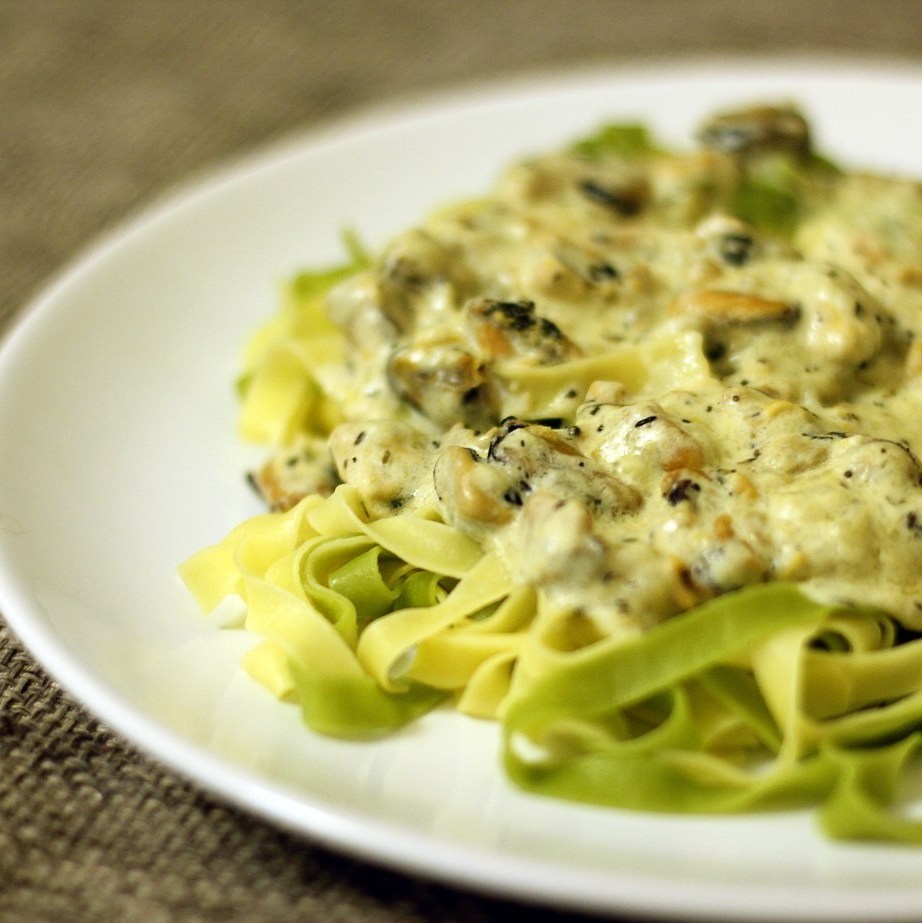
Ingredients:
Ingredients for pasta:
6 eggs - 6 pcs.
Ramson (spinach) - 45 g
Flour - 450 g
Semolina - 200 g
Cold pressed olive oil - 2 tbsp.
Ingredients for the sauce:
Finely chopped chicken breast (or minced chicken) - 200 g
Olive oil - 1 tbsp.
Onion - 1 pc.
Zucchini - 300 g
Cream 25% fat - 300 ml
Preparation: Wash the wild garlic leaves and grind in a blender to a puree consistency. Mix flour and semolina in a bowl. Make a hole in the form of a hole and break the eggs into it, add salt. Stir slowly with a fork, gently folding the bulk products into the eggs. Then add olive oil and wild garlic paste. Gently stir all this into the remaining dry ingredients and transfer the mixture from the cup to the cutting board for the dough. Knead the dough (we recommend dividing it into 4 parts, since rolling out this dough is very difficult, so it is better to do it in parts).
To cook Italian pasta you don’t need to be a chef or a native of the country where the dish came from. Increasingly, tourists travel around the world and learn about culture, customs, and cuisine. There are many varieties of Italian pasta; you can prepare the dish yourself and delight your household with it.
Carbonara pasta
- bacon - 120 gr.
- egg yolk - 4 pcs.
- spaghetti - 300 gr.
- cream of maximum fat content - 110 ml.
- garlic - 4 cloves
- salt - to taste
- grated parmesan - 65 gr.
- crushed pepper - to taste
- fresh parsley - 25 gr.
- olive oil - 40 gr.
- drinking water - 4 l.
- To begin, chop the bacon into small equal cubes and place in a hot frying pan with olive oil. Fry the product over medium heat, do not dry it out. Wait for a light crust to appear. At the same time, place an enamel pan of water on the stove.
- Pour the salt into the container with the liquid and bring the mixture to a boil. Next, place the spaghetti in the pan; cook the pasta until half cooked. The heat treatment time is 7-8 minutes if the product is made from durum wheat.
- Combine egg yolks, cream, salt and pepper to taste in one bowl. Use a whisk to whisk the mixture until smooth. Next, add grated Parmesan and stir thoroughly. Place the fried bacon on a separate plate.
- Chop the garlic and add to the frying pan. Get the product golden. As soon as the garlic is cooked, add the spaghetti to it and mix thoroughly. When the pasta is heated through, remove the heatproof container from the heat and pour in the egg mixture.
- Spaghetti must be stirred quickly enough, otherwise the yolks will curdle. After this, add the peppered bacon. Distribute the carbonara onto portioned plates, sprinkle each dish with grated cheese and fresh herb leaves.
Pasta with cherry tomatoes
- canned cherry tomatoes - 150 gr.
- garlic - 3 cloves
- spaghetti - 320 gr.
- ground red pepper - 4 gr.
- olive oil - 60 gr.
- basil - 20 gr.
- Pour olive oil into a Teflon frying pan and heat it, set the burner power to medium.
- After heating the container, add finely chopped garlic and ground red pepper. Mix thoroughly and bring the mixture to a bronze hue.
- Next, reduce the heat to low, add the tomatoes, removing the peels in advance. Meanwhile, boil the spaghetti until half cooked.
- Add pasta to all existing ingredients. Mix thoroughly and simmer the dish covered over low heat for 4-5 minutes.

- carrots - 3 pcs.
- broccoli - 340 gr.
- bell pepper(red) - 1 pc.
- spaghetti - 500 gr.
- cherry - 200 gr.
- fresh peas - 180 gr.
- allspice - 7 gr.
- garlic - 1 head
- olive oil - for frying
- parmesan - 100 gr.
- salt - to taste
- Peel and finely chop the garlic. Place in a frying pan with olive oil. Cook until golden brown, then add cherry halves and ground pepper, stir thoroughly. Simmer over low heat for about 15 minutes.
- Start cooking the spaghetti until half cooked. 4 minutes before the end of the manipulations, add vegetables to the pasta, and the bell pepper and carrots should be chopped into strips.
- After the time has passed, place the spaghetti with vegetables on a flat dish and add the prepared sauce. Sprinkle pasta with grated Parmesan.
Spaghetti with minced meat
- onion - 1 pc.
- minced beef - 120 gr.
- tomatoes - 3 pcs.
- garlic - 6 cloves
- tomato paste - 25 gr.
- granulated sugar - 12 gr.
- basil - 17 gr.
- red wine - 60 ml.
- oregano - 3 gr.
- parmesan - 75 gr.
- spaghetti - 100 gr.
- olive oil - 50 gr.
- You will need a deep non-stick frying pan. Pour olive oil into it and place the container over medium heat. Add minced meat and fry until golden brown. If a large amount of fat was released during the preparation of a meat product, you need to get rid of it.
- Peel the onion and garlic, chop finely, and add to the minced meat. Mix well and fry for a couple more minutes.
- After this, chop the herbs, garlic and tomatoes and place them in a common container. Add sugar, oregano, tomato paste and wine, stir, bring the mixture to a boil.
- Then reduce the heat to low and cover the pan with a lid. Simmer for about 35 minutes, do not forget to stir. Readiness is determined by the thickness of the composition.
- At the same time, place a pan of water, after the first bubbles appear, place the spaghetti in the container.
- The product must be cooked until half cooked. Place pasta on dishes and pour sauce over it. Sprinkle grated Parmesan cheese over the pasta. If you wish, you can add sprigs of fresh herbs.
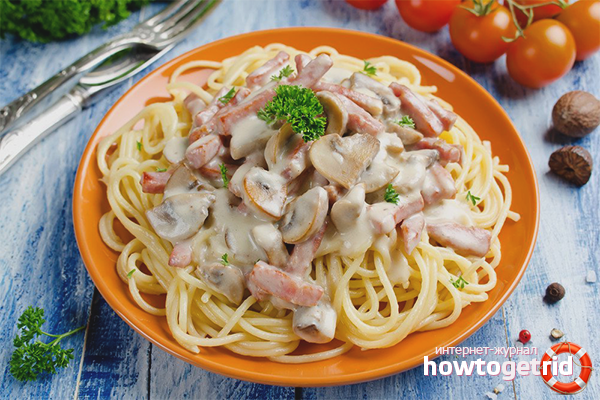
- mushrooms - 180 gr.
- onions - 1 pc.
- tomato paste - 55 gr.
- parsley - 20 gr.
- fresh tomatoes - 350 gr.
- minced beef - 450 gr.
- garlic - 6 cloves
- olive oil - 75 gr.
- red wine - 150 ml.
- lasagna (plates of dry dough) - 400 gr.
- Dutch cheese - 400 gr.
- milk - 400 ml.
- Parmesan cheese -200 gr.
- butter - 150 gr.
- premium flour - 60 gr.
- Ricotta cheese - 130 gr.
- cream - 170 ml.
- quail eggs - 4 pcs.
- Preheat oven to 180 degrees. To prepare the pasta, you will need a deep, heat-resistant rectangular dish. Lubricate it a small amount any fat.
- At the same time, place a large Teflon frying pan with olive oil on the burner. When the container is hot, add finely chopped onion and garlic into it. Fry until golden brown over medium heat.
- After this, add chopped mushrooms to the mixture. Wait 3-4 minutes, pour in tomato paste, chopped tomatoes and wine. Reduce the burner to low and bring the mixture to a boil.
- Excess liquid should evaporate. After this, add salt and pepper, add chopped parsley. Then start making the white sauce. Place the saucepan on the stove, add butter and melt until liquid.
- Slowly start mixing in the flour, avoiding any lumps. Simmer the mixture over low heat for 5 minutes. After this, remove the saucepan from the stove and pour in the milk. Stir the mixture thoroughly until smooth. It is important that the milk is a little warm.
- After mixing, return the ingredients to the stove and allow to simmer over low heat. Simmer for 4 minutes, the mass should become thick. Next, add pepper, salt and finely grated Ricotto cheese.
- Proceed to the next step, take a baking dish and place lasagna dough on the bottom. It is recommended to read the included instructions for preparing the plates. You may need to dip the mixture in boiling water for a couple of minutes before baking. Once you have finished the lasagna, place it in the pan, overlapping it.
- Next, lay out the minced meat without lumps and pour in half of the creamy sauce. Grate all the remaining cheese (Parmesan, Dutch). Sprinkle ¼ of the total volume of minced meat with sauce.
- Keep adding layers until you run out of ingredients. The last ingredient should be the lasagne sheets. Take a small bowl, combine eggs and cream in it, bring the mixture until smooth.
- Pour the resulting mixture over the lasagna and sprinkle with grated cheese. After this, place the mold in the oven for 35 minutes at 180 degrees. Readiness is determined by eye; the dish should be covered with a golden crust. Allow the dish to sit for 10 minutes before serving.
- When preparing pasta, it is strictly forbidden to add it to spaghetti. natural oil when cooking. This move will impair the ability of the pasta to absorb the sauce.
- It is also not recommended to rinse cooked spaghetti under cold water. If the pasta sticks together, try using boiling water to loosen the balls.
- It is strongly recommended to store the ingredients and the sauce itself in ceramic or glass containers. The paste should be kept in similar containers and stirred only with a wooden spatula.
Do not store or allow tomato ingredients to come into contact with metal containers. Such products are prone to oxidation and deterioration in taste. Create your own unique pasta recipes by experimenting with cheese varieties and spices.
Video: pasta in tomato sauce
Meat, vegetables, spices, which are cooked and eaten immediately, since standing pasta is no longer as tasty as fresh one. There is a wide variety of pasta: spaghetti, lasagna, fettuccine, ziti, cannelloni, cavatappi and many others. They all differ in color, shape, length, these can be letters, vermicelli, thin sheets, bows, shells.
How to cook spaghetti pasta
Carbonara
What is necessary :
- a pack of spaghetti;
- 90 g bacon;
- 70 g durum;
- a pair of chicken eggs;
- yolk;
- a tablespoon of salt and olive oil;
- black pepper ;
- clove of garlic.
How to cook :
- Pour a lot of water into a deep saucepan, add salt and bring to a boil. Add pasta and cook according to package instructions.
- While the spaghetti is boiling, you can prepare the sauce. Cut the bacon into small pieces and fry with olive oil and garlic for no more than 6 minutes.
- In a bowl, beat the yolk, eggs, grated cheese and pepper.
- Drain the finished spaghetti into a colander, but reserve half a glass of liquid after cooking the pasta.
- Mix the spaghetti in a frying pan with the bacon, then pour the cheese sauce over it. Stir quickly until the mixture covers the pasta entirely. If the sauce is too thick, then you can add a couple of spoons of “pasta broth”.
Creamy mushroom pasta
Ingredients :
- 300 g champignons;
- bulb;
- 200 ml each of water and cream;
- 20 g butter;
- pepper, salt, a couple of tablespoons of flour.
How to cook :
- Grate the mushrooms or finely chop them with a knife.
- Heat butter in a saucepan and fry finely chopped onion. When the onion becomes almost transparent, add the mushrooms and cook until the liquid disappears.
- Salt the mushrooms and onions, add flour, stir thoroughly.
- Pour a glass of boiling water into a saucepan, stir, then pour in warm cream and pepper. There is no need to bring to a boil.
- Boil the spaghetti and mix it with the prepared mushroom sauce.
How to cook tomato pasta

Creamy tomato paste
What you will need:
- two tomatoes;
- two onions;
- half a spoon of adjika;
- 110 ml;
- basil;
- salt, black pepper;
- any pasta pasta products.
How to:
- Prepare pasta.
- While the pasta is boiling, chop the onion, peel and chop the tomatoes.
- Pour a little oil into a saucepan, fry the onions and add tomatoes.
- Pour cream, salt, pepper, sprinkle with basil.
- Add adjika and simmer for 5-7 minutes, then mix with paste.
Light tomato paste
What do you need :
- a couple of tomatoes;
- bell pepper;
- salt, granulated sugar, black pepper;
- two cloves of garlic;
- dill, oregano, basil;
- pack of pasta for pasta.
How to cook :
- Scald the tomatoes with boiling water and remove the skins from them., divide into four parts and remove seeds.
- Also remove the skin from the pepper. Grind the vegetables into a paste using a blender.
- Pour the liquid into a saucepan, add salt, pepper, garlic, spices and herbs.
- After boiling, reduce heat and cook for a quarter of an hour.
- Mix the sauce with the cooked pasta.
Bolognese with minced meat
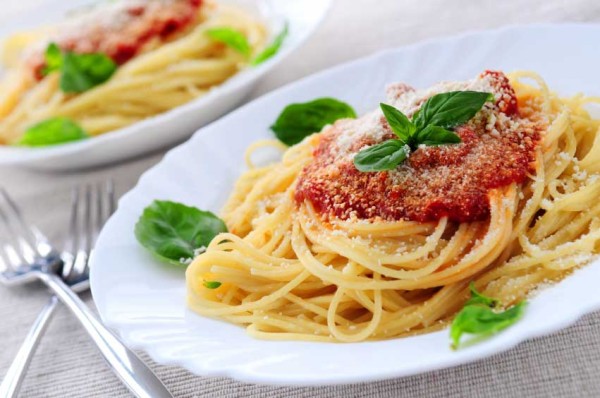
What is necessary :
- half a kilo of minced meat;
- three onions;
- 210 g tomato paste;
- oregano, paprika, black pepper, salt, chili pepper;
- 4 -5 tomatoes;
- two garlic cloves;
- a spoonful of honey;
- 130 ml red;
- two packs of spaghetti;
- basil;
- 110 g hard cheese;
- two spoons.
How to cook :
- Heat oil in a saucepan and prepare chopped onion.
- Add minced meat, cook until almost done.
- Pour over the wine and simmer until it evaporates.
- Add seasonings, tomatoes, chili, tomato paste, garlic and honey to the meat. Crush the tomatoes with a spoon, after boiling, cook for 2-2.5 hours until thick.
- Prepare spaghetti. Transfer to a plate, pour over the sauce, cover with grated cheese and basil.
How to cook Italian pasta
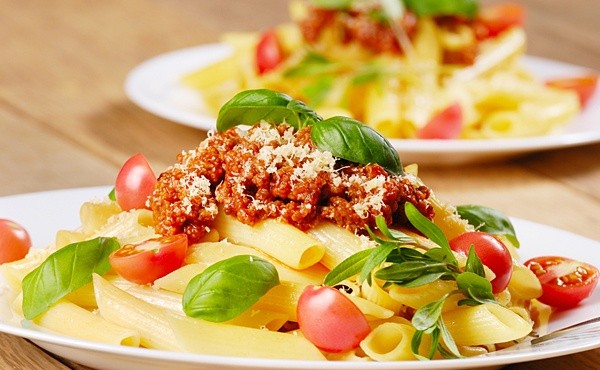
Roman buccatini
What is necessary :
- 600 g spaghetti;
- 200 g mozzarella;
- two red onions;
- olives ;
- hard cheese;
- 700 g tomatoes;
- olive oil, salt, pepper;
- parsley, oregano, garlic.
How to cook :
- Peel the tomato from skin and seeds, grind in a blender with oregano.
- In a bowl, mix the tomato mixture, chopped garlic, chopped mozzarella, onion, olive oil.
- Prepare the pasta. Combine with dressing and sprinkle with grated cheese.
Classic lasagna
What do you need :
- 10 sheets of lasagna pasta;
- half a kilo of minced meat;
- 400 g hard cheese;
- 50 g butter;
- two spoons of flour;
- 650 ml milk;
- 500 ml Bolognese sauce.
How to cook :
- Melt butter in a deep frying pan. Add flour, stirring thoroughly.
- Pour in milk and simmer until slightly thick. This will be bechamel sauce.
- In another frying pan, heat the olive oil and fry the minced meat until almost done, pour in the Bolognese sauce, adding pepper and salt.
- Preheat the oven to 180 degrees.
- Grease a special form with butter. Cover the bottom with a small amount cooked bechamel sauce.
- Line the mold with dry lasagna slices, place minced meat, grated cheese and bechamel on top. There is no need to skimp on the sauce and minced meat; the more sauce, the juicier the future lasagna.
- Repeat layers. The very last layer is dry sheets, bechamel sauce and a lot of grated cheese.
- Leave for 10 minutes, then cook in the oven for half an hour.
Pappardelle Bolognese
Ingredients :
- half a liter of tomato.
How to cook :
- Fry chopped vegetables, herbs and garlic in oil.
- Mix the minced meat with pepper and salt and add to the vegetables. Cook for 10 minutes.
- Pour in wine and simmer until the alcohol disappears.
- Add tomato paste and juice with half a liter of clean water.
- Bring everything to a boil and simmer for a couple of hours until thick.
- Cook the pasta, mix with the dressing and lightly fry for no more than a minute.
- Sprinkle with grated cheese and serve.
06 May 2017 298
Spaghetti is very tasty dish, which many people prepare for lunch or dinner. This dish can be combined with various sauces made from meat, vegetables, cream and even other side dishes. The most important ingredient, without which this treat cannot be made, is the sauce; it is the soul of spaghetti.
The sauce or paste is the basis of this dish, which gives it a wonderful aroma and unique taste. Therefore, you definitely need to be able to cook pasta yourself, especially since it is not very difficult.
Bolognese at home
What components will be required:
- 400 grams of beef;
- pork meat – 200 grams;
- one onion;
- 2 carrots;
- 3 garlic cloves;
- 40 ml olive oil;
- dry white wine – 170 ml;
- tomato paste – 150 grams;
- celery stalks - a bunch of 50 grams;
- 30 grams of cow butter;
- 300 ml beef broth;
- 2 teaspoons dried basil;
- 150 ml cream;
- spices and salt.
Cooking time: 1 hour 20 minutes.
Calorie content – 420 kcal.
How to prepare Bolognese pasta for spaghetti with minced meat:

How to make tomato paste for tomato spaghetti
Products for cooking:
- tomatoes – 700 grams;
- 300 grams of onion;
- ½ garlic head;
- a couple of basil stems;
- tomato paste – 60 grams;
- salt to your taste;
- vegetable oil.
How long does it take to prepare – 40 minutes.
Calorie content – 257 kcal.
Cooking process:
- Remove the skin from the onion and cut into small cubes;
- Pour vegetable oil into a frying pan and heat it;
- Place small pieces of onion in hot oil and fry them for about 5 minutes;
- Peel the garlic and chop into thin slices;
- We wash the basil stems and chop them into small slices;
- Add basil to the onion and garlic. Mix all components thoroughly;
- Leave to fry for another 5 minutes and remove from heat;
- We wash the tomatoes. They should be grated or through a sieve;
- The result should be a tomato mixture made from fresh tomatoes;
- Place the frying pan with onions, garlic and basil back on the heat;
- Pour in the tomato mixture, stir and leave to simmer;
- After 10 minutes, add a couple of large spoons of tomato, mix and leave to simmer;
- The tomato will add a pleasant aroma and thickness;
- Simmer over low heat until boiled;
- At the end, add salt and simmer for about 5-7 minutes;
- Add the prepared tomato sauce to the spaghetti, mix and serve.
Carbonara for spaghetti

- 150 grams of bacon;
- cream with 20% fat content - 150 ml;
- 50 gram piece of Parmesan cheese;
- three egg yolks;
- 1/3 of a head of garlic;
- vegetable oil for frying;
- salt to your taste;
- spice mixture.
Cooking period: 60 minutes.
Calorie content – 385 kcal.
How to properly prepare creamy pasta Carbonara:
- A piece of bacon must be cut into strips;
- Peel the garlic cloves and cut them into small pieces or pass them through a press;
- Pour a little vegetable oil into the frying pan, turn it to gas and heat it up;
- Place garlic in hot oil and fry it for a couple of minutes;
- Then add the bacon to the garlic and fry for a while, stirring constantly;
- Grate a piece of cheese with fine shavings;
- Place three egg yolks in a cup;
- Add salt and ground black pepper to the yolks and beat thoroughly until smooth;
- Add the grated cheese to the yolks and stir again.;
- Next, set the spaghetti to boil in salted water;
- After the spaghetti is ready, you need to rinse it;
- Place it in a frying pan and fill it with sauce made from yolks and cheese. Mix well;
- Then place the fried bacon on top and stir thoroughly again;
- If desired, spaghetti can be topped with grated cheese.
Making Mediterranean sauce
For preparation you will need the following components:
- seafood mussels, shrimp, vongole. Seafood should be approximately 300-400 grams;
- cherry tomatoes – 6-7 pieces;
- white table wine – 1 glass;
- 5-6 sprigs of parsley;
- olive oil;
- salt to your taste;
- ground black pepper - a few pinches;
- tomato juice – ½ cup.
Cooking time – 1.5 hours.
Calorie content – 395 kcal.
How to make delicious seafood spaghetti pasta:
- The first step is to clean the mussels;
- Vongole, mussels and other types of shells should be placed in a container with salt water and left for several hours;
- Next, you need to remove all the shells from the water, unopened and broken shells should be removed;
- Rinse all normal shells thoroughly under cool water;
- It is necessary to remove the skin from the garlic cloves and chop them into small pieces;
- Add olive oil to the frying pan, add garlic and fry a little;
- Rinse the parsley and cut into small pieces;
- Pour boiling water over the tomatoes and cut off the skin, cut the tomatoes into two parts;
- Place tomatoes in a roasting pan with garlic and add parsley;
- Cook over low heat, the structure of the tomato should become soft;
- Next, pour in white wine and cook for about 5 minutes;
- Vongole and other shells, except mussels, should be placed in the sauce. Cover the roasting pan with a lid and reduce the heat;
- After the shells are fully opened, other seafood products are added and tomato juice is poured. Cook for 5-7 minutes;
- Mussels must be cooked separately. To do this, they need to be placed in a deep frying pan, add oil and put on fire;
- Add small pieces of garlic and chopped parsley;
- Cook the mussels under a closed lid over low heat until they open;
- After this, put the mussels in the sauce with the rest of the seafood and simmer for another 5-7 minutes;
- Next, boil the pasta and add it to the sauce;
- Mix the spaghetti with the sauce and serve.
How to make delicious mushroom pasta
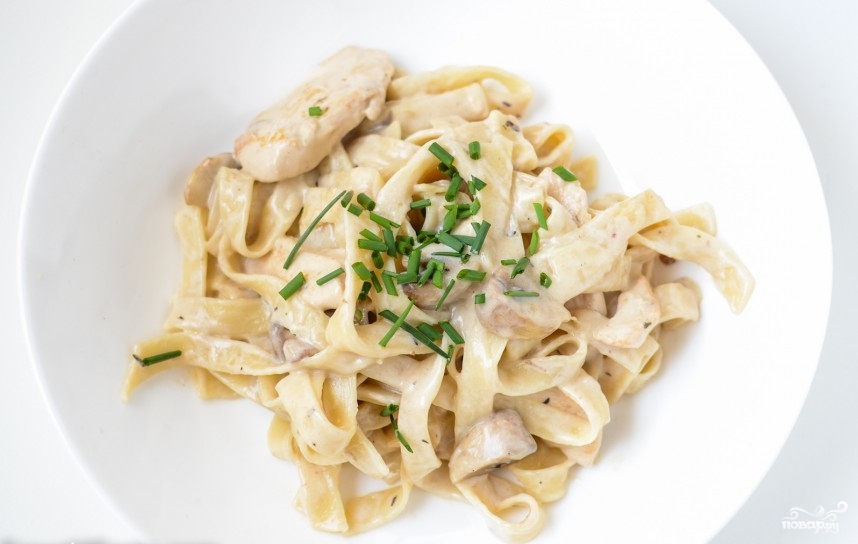
Products for cooking:
- 3 small spoons of cow butter;
- one onion;
- garlic – 3 cloves;
- fresh champignons – 300 grams;
- a glass of cream;
- 70 gram piece of cheese;
- a pinch of salt;
- dry greens - a pinch.
Cooking time: 40 minutes.
Calorie content – 320 kcal.
How to cook:
- Peel the skin from the onion and cut the head into small cubes;
- Peel the garlic cloves and chop them into thin slices;
- Place cow's butter in a frying pan and melt;
- Add the onion to the oil, stir and fry for about 5-7 minutes;
- We wash the champignons, peel the caps and cut them into small pieces;
- Add pieces of mushrooms along with garlic to the onion;
- Add salt, pepper and simmer until done;
- Pour cream into a saucepan and put it on gas. Boil the cream until boiling;
- Next, pour the cream over the mushrooms and simmer for about 10 minutes;
- We wipe the cheese, put half of it into the hot sauce, and leave the other half for serving;
- Add spaghetti to the sauce, stir, sprinkle with grated cheese and serve.
“Ai cuatro formaggi” with chicken
Ingredients for cooking:
- chicken fillet 250 grams;
- onion head;
- two cloves of garlic;
- a small slice of cheese 50-70 grams;
- vegetable oil;
- 70 gram slice of cow butter;
- fresh greens – 5-6 branches;
- salt to your taste;
- seasoning mixture
Cooking period – 1 hour.
Calorie content – 359 kcal.
How to prepare Ai Cuatro Formaggi cheese pasta for spaghetti with chicken:
- Wash the chicken meat and cut into thin strips;
- Remove the skin from the onion and cut into thin half rings;
- Remove the skins from the garlic cloves and chop them into small pieces;
- Add vegetable oil to the frying pan, add a piece of cow butter and heat it up;
- Add onion and garlic to the oil and fry for a while;
- Then add pieces of chicken to the onion and garlic;
- Fry the meat for about 3-5 minutes;
- After this, add 1 large spoon of tomato paste;
- Mix all components thoroughly;
- Then pour half a glass of water, season with salt, spices and stir;
- Simmer over medium heat for 7-10 minutes;
- Place the spaghetti into the prepared sauce, mix and serve.
- instead of tomatoes, you can use pureed fresh tomatoes in some types of sauces;
- be sure to add herbs, herbs, and spices. These components give aroma and original taste;
- It should be served hot, because it is in this form that the pasta retains all its taste and aroma.
If you still don’t know how to diversify your menu, then you can safely use a delicious and original treat from Italian cuisine - pasta. It can be made with various sauces that will give this dish a spicy taste and aroma.
The “ancestors” of modern Italian pasta appeared in the 1st century and were wide noodles made from durum wheat, which were not boiled, but baked in the oven. A little later, under the influence of Arab cuisine, the Italians began to add spices to the dough, and in the 14th century, pasta finally received its current name “pasta” (“dough”). Due to the possibility of long-term storage, pasta became a popular food for travelers and sailors, although it was eaten with hands, so this dish was considered food for commoners.
After the invention of a special four-pronged fork, which made it possible to deal with long pasta in an elegant manner, the dish became part of the diet of the upper class, while methods of preparing and serving it were improved.
Soon they began to cook it in milk with sugar and serve it with butter and cheese, but only wealthy people could afford this delicacy, and the poor limited themselves to pasta with garlic and vegetables. Since the 19th century, after the invention of the machine for making pasta, it began to be produced on an industrial scale, although the first recipes for the dish were published already in the 10th century by the Italian chef Martin Corno in the culinary collection “The Art of Cooking Sicilian Pasta and Vermicelli.” Pasta is now considered the national Italian dish, and there are dozens of types, although the term “pasta” is used to refer to all types of dough products. Italians love pasta and eat 25–30 kg of it a year, because for them it is not just a national dish, but also an exquisite delicacy and the best delicacy in the world.
Types of Italian pasta and secrets of their preparation
Many Russians call any type of pasta pasta, and this is not entirely correct. Pasta, which is a hollow tube, is a type of Neapolitan pasta made from soft wheat flour. Pasta can also be dry and fresh - fresh pasta is prepared immediately before cooking from eggs and white flour, and dry pasta is made for future use from water and durum wheat flour so that it can be stored longer and does not fall apart during cooking.
Now let’s try to figure out what types of pasta exist, how they differ from each other and how to cook them correctly.
Straight and long types of pasta
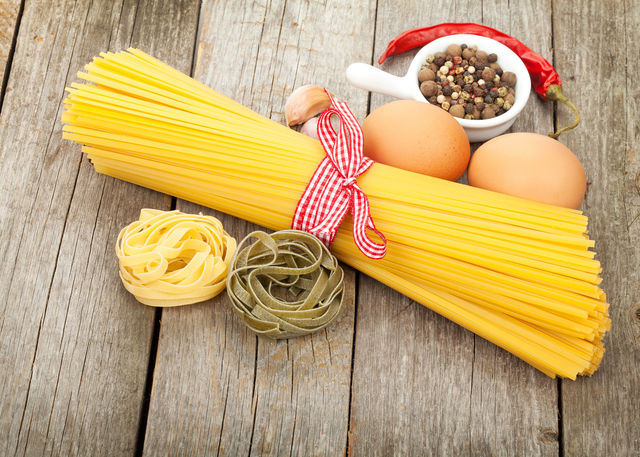
Spaghetti- a paste that is the basis for other types of pastes, and this word is translated as “small ropes”, their diameter is 1.8–2 mm, and their length reaches 15 cm or more. Thin spaghetti is known in cooking as spaghettini, and thick ones - like spaghettoni. They are served with thick tomato and cheese sauces, flavored with spices and garlic. This group also includes capellini- thin spaghetti with a diameter of just over 1 mm, intertwined in the form of balls resembling nests, which are called “angel hair”. Typically this paste is used to season soups and broths, and as a second course it is served with hot light sauces and vegetables. Vermicelli, called "little worms", are somewhat similar to capellini and are prepared in a similar way, and are served both cold and hot. Name of narrow, flat and long pasta linguini translated as “small tongues.” This pasta is considered versatile and delicious with any dressing, especially pesto, seafood sauce, ham, cheese and cream.
Fettuccine, a 1cm wide ribbon paste sold in rolled nests, is especially fond of creamy sauces and olive oil gravies. A popular type of tape paste is lasagna, which is made from rectangular sheets with straight or curly edges. When finished, lasagna resembles an oven-baked cake made from layers of pasta with meat, fish, vegetable and cheese fillings, topped with thick tomato and creamy sauces. Pappardelle, long egg noodles 2 cm wide, are very similar to fettuccine, and translated the name sounds like “eating greedily”, since this pasta is very tasty and sometimes difficult to stop tasting. Parpadelle cooks for just two minutes and is used to make casseroles or served with meats in thick, savory sauces. Another tape paste, tagliatelle, 5–8 mm wide, does not look as flat as fettuccine, has a porous structure that absorbs various ingredients well, and is usually served in casseroles, with soups, meat and thick Bolognese sauces. Pasta in the form of a long ribbon with wavy edges Reginette(mafaldine), invented in Naples, is served with Neapolitan sauce, seafood and curry, which must include saffron, ginger and horseradish.
Pasta with twisted and curly shape
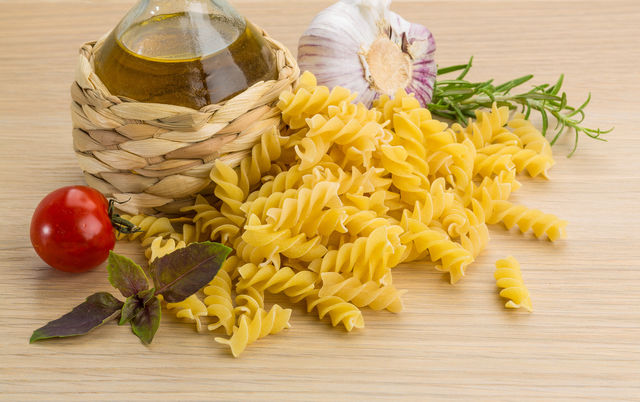
Spiral shaped paste is called fusilli spiral(“small wheels”) - they can be short and long, thin and thick. Multi-colored fusilli are ideal for salads and soups, they are served as a side dish with pesto sauce and give dishes a bright, unusual look. There are the following types of dough spirals: mini fusilli(small spirals) fusilli bucati corti(hollow spirals), fusilli rigati- pasta with grooves for better absorption of sauce. Short spirals, equal in thickness to spaghetti, rotini, served both cold and hot, in salads or with very thick sauces.
Hollow pasta
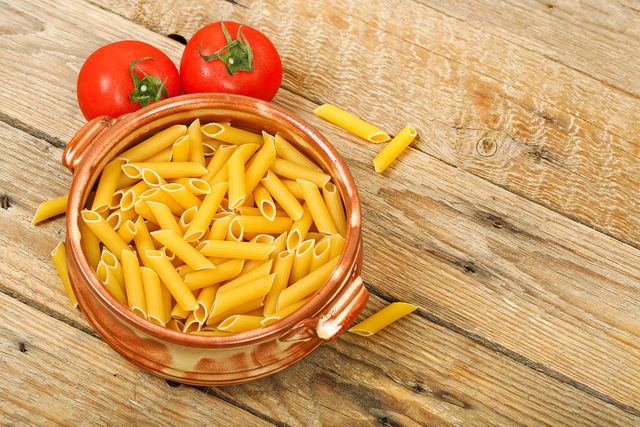
Small short tubes are called in Italian ditalini(“thimbles”) - they are very popular in Sicily, where they are served with mushroom, tomato, garlic sauce, ricotta cheese and broccoli. Elbow macaroni(horns) are used for cooking dishes with cheese, in soups and vegetable salads, and hollow spaghetti pechutelle incredibly tasty with eggplant and meat sauces. Wedding pasta ziti 20 cm long are broken into several pieces before cooking, and the pasta penne(“feathers”) with oblique cuts and grooves and medze penne rigate(half the length of penne) easily hold the sauce inside and outside, combining amazingly with any food. Medze manike are a broader variation of penne and are combined with onions and zucchini. Cannelloni- large middle length tubes with a smooth surface, served hot, with minced meat and thick sauce. Cavatappi, medium-sized hollow “worms”, served both cold and hot, with various sauces.
Unusual pasta of various shapes
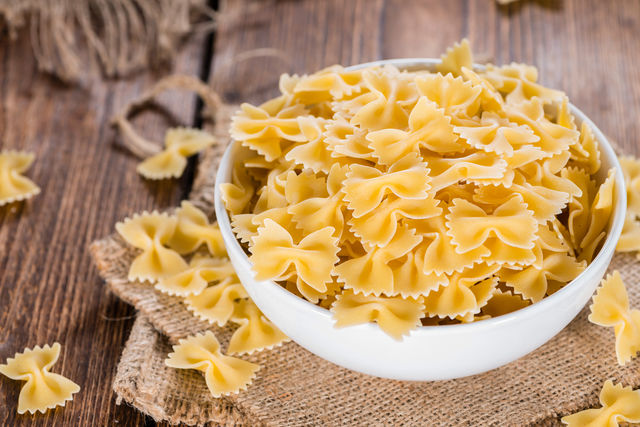
Children's pasta alphabet, made from selected wheat, filtered water and natural additives, is shaped like letters and is designed specifically for baby food. Graceful rings Anelli, squares quadretti, stars Stelina, original pasta farfalle in the form of bow butterflies, familiar to us by their shell shape conchiglie, pasta orzo, rice-like, wheel-shaped pasta rotelle and radiators radiators used in the preparation of soups, salads and gourmet side dishes. Pasta castellanes, reminiscent of bell skirts, was first prepared in the Italian city of Parma, and is traditionally served with cauliflower sauce. Among unusually shaped pastes, there are also: perlini- small pearl shells, lumakoni- large snails, Kiffery- small snails, orecchiette- resemble halves of a walnut, grattoni- small balls, merletti- round medallions with ornaments.
Stuffed pasta
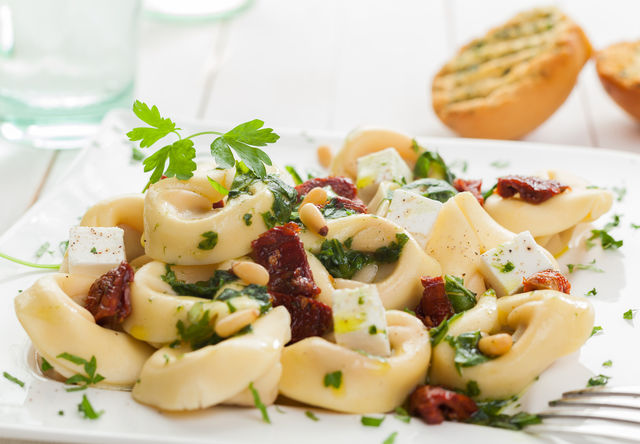
In Italy, pasta intended for stuffing is very popular. Pasta angelotti in the shape of a crescent, they are filled with cottage cheese, meat, cheese and spinach. Gnocchi(“small dumplings”) go perfectly with semolina and vegetables. Tortellinni, ring-shaped dumplings, are stuffed with vegetables, cheese, squid, and served with thick sauces or olive oil, Parmesan, pepper and garlic. Square dumplings ravioli prepared with meat, fish, cheese, vegetable and sweet fillings, and topped with exclusively simple sauces that do not interrupt the main taste of the dish.
How to cook pasta correctly
The main method of preparing pasta is boiling it in large quantities water. Italian pasta does not contain salt, so you need to salt the water before adding the product.
The pasta should only be immersed in boiling water, and most importantly, do not cover it with a lid! Long views There is no need to break the paste, just wait until the bottom part softens and press down on the top part. When the pasta is ready, quickly drain the water and immediately toss the pasta with olive oil or sauce so that the flavors meld together.
The cooking time for the pasta depends on its size and thickness. For example, thin “angel hair” will be ready in 2–3 minutes, large snails and all kinds of tubes will be cooked in about 15 minutes. In any case, pay attention to the packaging. Don’t forget that pasta for salads and as a side dish is usually cooked “al dente” - not until completely softened, but so that there is a hard core inside. Pasta cooked al dente has been shown to contain fewer calories than pasta that is fully cooked. Italians don't always cook pasta in water. If pasta is cooked in meat or chicken broth, the result is pastina - a light soup made from broth and pasta.
Carbonara and Neapolitan sauce
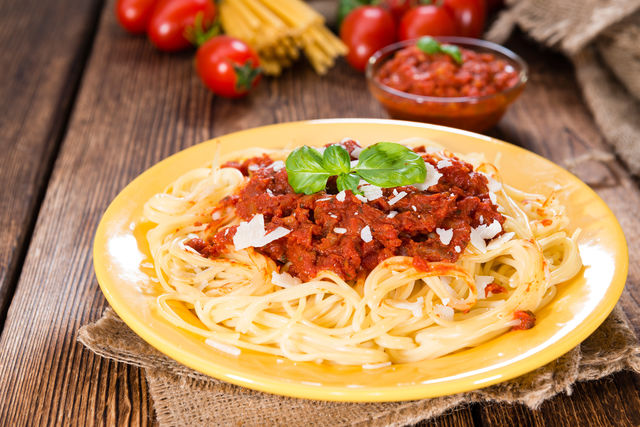
Making pasta sauce is considered the highest culinary art in Italy; it is no coincidence that Italian chefs say: “Pasta is the body, and sauce is the soul.” The sauce is often mixed with other products to add piquancy and richness to the dish. Pasta carbonara is one of these national masterpieces, which is spaghetti with slices of bacon or raw smoked ham, drenched in a cream-based egg and cheese sauce, to which other ingredients are added depending on the recipe - cognac, white wine, chicken broth, basil, parsley , parmesan, zucchini, garlic, pecorino cheese, olive oil and black pepper.
If penne pasta is seasoned with Neapolitano sauce, made from stewed tomatoes and carrots, with Parmesan, celery, basil and onions and garlic fried in olive oil, you get a dish that in past centuries graced the royal table.
How to serve pasta correctly? The most important rule: it is not customary to serve pasta without a sauce - meat, fish, cream, mushroom, vegetable, cheese, nut or tomato. The sauce can be delicate, light, airy, thick, spicy, fatty, sour or sweet, but whatever sauce you choose, it will almost always contain Parmesan, olive oil, garlic, aromatic herbs and spices. Short views Pastas are best combined with sauces that contain pieces of meat, fish and vegetables, and long pasta is in harmony with homogeneous gravies. The sauce transforms the taste of pasta, saturates it with new shades and turns it into a royal delicacy - it is no coincidence that this dish is considered one of the most popular and beloved in world cuisine. An Italian proverb states: “If you want to live forever, eat pasta.”









